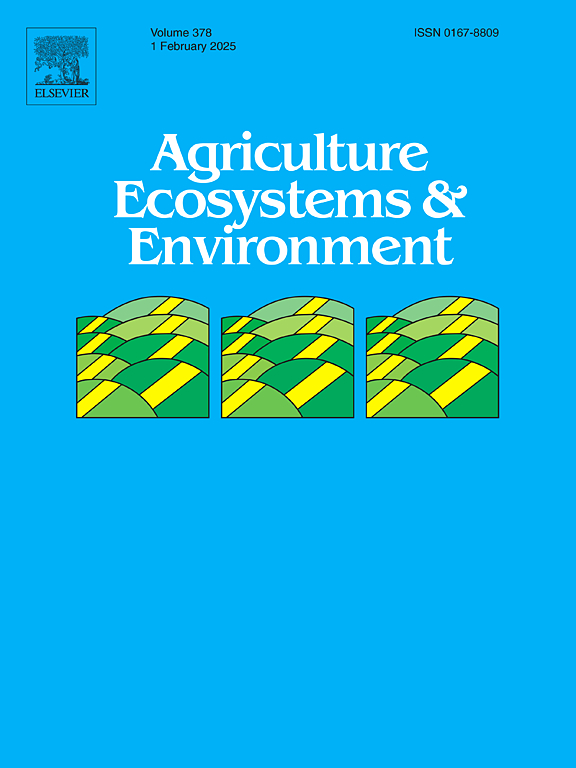Stage-specific phosphorus mobilization enhances phosphorus uptake in relay-intercropped soybean
IF 6
1区 农林科学
Q1 AGRICULTURE, MULTIDISCIPLINARY
引用次数: 0
Abstract
Intercropping systems exploit the phosphorus (P)-activating ability of leguminous plants to enhance P acquisition. However, the specific P mobilization strategies used by leguminous plants, such as soybean (Glycine max L.), at different growth stages remain unclear. This study examined the P mobilization strategies of soybeans across developmental stages within a maize-soybean relay intercropping system. A 2-year field experiment was conducted to assess variations in P accumulation, root growth, organic acid (OA) secretion, acid phosphatase (APase) activity, and soil P fraction dynamics from the seedling stage to full pod development. Intercropped soybean mobilized P through growth-stage-specific strategies. During the beginning flowering (R1) stage, root OA secretion in intercropped soybeans peaked. Under both P0 and P20 application conditions, the average secretion level was approximately 40 % higher than that in monocropped soybeans. This OA secretion advantage persisted until the beginning pod (R3) stage, after which, OA levels became comparable with those in monocropped plants. At R3, regardless of P application, APase activity in intercropped soybean peaked and was significantly higher than that in monocropped soybeans. This advantage over monocropping persisted until the beginning seed (R5) stage. Soil available P (AP) content at R3 was significantly higher in intercropping and remained elevated through R5, supporting P uptake during the pod-filling stage. Correlation analysis revealed that soil AP content at R3 was highly significantly correlated with OA secretion at R1 and APase activity at R3. Further structural equation modeling revealed that early OA secretion released stable P pools, while later APase activity maximized P availability from organic sources. This process aligned P mobilization with the peak growth demands of soybeans. These findings provide insights into how relay intercropping synchronizes P mobilization with the developmental requirements of soybeans.
间作利用豆科植物对磷的激活能力,提高了对磷的吸收。然而,豆科植物如大豆(Glycine max L.)在不同生长阶段的具体磷动员策略尚不清楚。本研究考察了玉米-大豆接力间作系统中大豆各发育阶段磷的动员策略。通过为期2年的田间试验,研究了油菜从苗期到全荚发育期间磷积累、根系生长、有机酸(OA)分泌、酸性磷酸酶(APase)活性和土壤磷组分的变化。间作大豆通过生长阶段特异性策略调动磷。初花期(R1)是间作大豆根系OA分泌高峰。在P0和P20施用条件下,平均分泌量比单作大豆高约40 %。这种OA分泌优势一直持续到开始豆荚(R3)阶段,之后,OA水平与单作植物相当。在R3时,无论施磷量如何,间作大豆的APase活性均达到峰值,且显著高于单作大豆。这种优于单作的优势一直持续到开始播种(R5)阶段。套作期间,R3土壤速效磷(AP)含量显著高于R5,支持灌浆期的磷吸收。相关分析表明,R3土壤AP含量与R1 OA分泌和R3 APase活性呈极显著相关。进一步的结构方程模型显示,早期OA分泌释放稳定的磷库,而后期APase活性最大化有机来源的磷利用率。这一过程使磷动员与大豆的生长高峰需求一致。这些发现有助于了解间作如何使磷的动员与大豆的发育需求同步。
本文章由计算机程序翻译,如有差异,请以英文原文为准。
求助全文
约1分钟内获得全文
求助全文
来源期刊

Agriculture, Ecosystems & Environment
环境科学-环境科学
CiteScore
11.70
自引率
9.10%
发文量
392
审稿时长
26 days
期刊介绍:
Agriculture, Ecosystems and Environment publishes scientific articles dealing with the interface between agroecosystems and the natural environment, specifically how agriculture influences the environment and how changes in that environment impact agroecosystems. Preference is given to papers from experimental and observational research at the field, system or landscape level, from studies that enhance our understanding of processes using data-based biophysical modelling, and papers that bridge scientific disciplines and integrate knowledge. All papers should be placed in an international or wide comparative context.
 求助内容:
求助内容: 应助结果提醒方式:
应助结果提醒方式:


